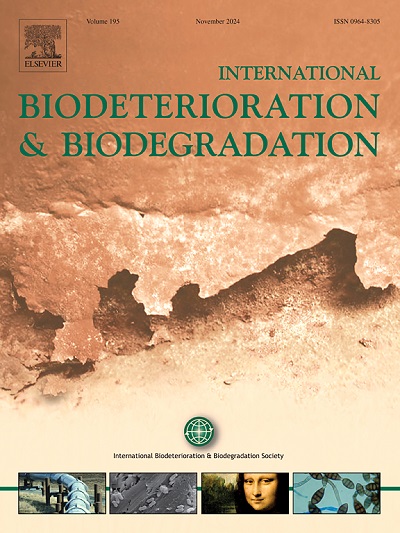Unraveling the genomic and metabolic mechanisms of pyrene and phenanthrene degradation by Mycolicibacterium sp. SCSIO 43805: A high-Efficiency bacterium isolated from seagrass sediment
IF 4.1
2区 环境科学与生态学
Q2 BIOTECHNOLOGY & APPLIED MICROBIOLOGY
International Biodeterioration & Biodegradation
Pub Date : 2025-04-19
DOI:10.1016/j.ibiod.2025.106101
引用次数: 0
Abstract
The ability of microorganisms to break down persistent organic pollutants in the environment has sparked significant interest in bioremediation, as it provides a firm foundation for implementing an effective, robust, and eco-friendly approach. In this study, we isolated a bacterium, identified as Mycolicibacterium sp. SCSIO 43805, from seagrass sediments and studied its potential for degrading pyrene and phenanthrene. The stain effectively degraded pyrene and phenanthrene, both provided at a concentration of 50 mg/L, within 12 days of incubation, as evidenced by the absence of any noticeable peaks related to pyrene and phenanthrene in the GC-MS profile of the 12-day extract. Moreover, the whole genome sequence analysis unveiled a comprehensive array of genes crucial for the complete degradation of polycyclic aromatic hydrocarbons. Multiple copies of dioxygenases such as nidA, nidB and nidD and monooxygenase such as cytochrome P450, which are essential for initial cleavage of aromatic rings, were detected in the genome of the Mycolicibacterium sp. SCSIO 43805. Furthermore, based on the gene contents and metabolic profiling of the extracts, we speculated that Mycolicibacterium sp. SCSIO 43805 could degrade pyrene, phenanthrene and other PAHs via phthalate and β-Ketoadipate pathway. The comparative genomics with other member of the genus Mycolicibacterium showed that Mycolicibacterium sp. SCSIO 43805 possessed a maximum number of genes involved in polycyclic aromatic hydrocarbon degradation. Hence, based on results of genomic, comparative genomics and metabolic profiling, Mycolicibacterium sp. SCSIO 43805 demonstrated high ability in degrading persistent organic pollutants and is an excellent biological agent for bioremediation of contaminated environment.
从海草沉积物中分离的高效菌——分枝杆菌SCSIO 43805降解芘和菲的基因组和代谢机制
微生物分解环境中持久性有机污染物的能力引发了人们对生物修复的极大兴趣,因为它为实施有效、稳健和环保的方法提供了坚实的基础。本研究从海草沉积物中分离出一株细菌,鉴定为分枝杆菌sp. SCSIO 43805,并对其降解芘和菲的潜力进行了研究。该染色剂在培养12天内有效降解了浓度为50 mg/L的芘和菲,在12天提取物的GC-MS谱图中没有任何与芘和菲相关的明显峰。此外,全基因组序列分析揭示了一系列对多环芳烃完全降解至关重要的基因。在分枝杆菌SCSIO 43805的基因组中检测到多个双加氧酶(如nidA、nidB和nidD)和单加氧酶(如细胞色素P450),它们是芳香环初始切割所必需的。此外,根据提取物的基因含量和代谢谱分析,我们推测Mycolicibacterium sp. SCSIO 43805可能通过邻苯二甲酸盐和β-酮己二酸途径降解芘、菲等多环芳烃。与其他分枝杆菌属成员的比较基因组学研究表明,分枝杆菌sp. SCSIO 43805具有最多的多环芳烃降解相关基因。因此,基于基因组学、比较基因组学和代谢谱分析的结果表明,分枝杆菌sp. SCSIO 43805具有较高的降解持久性有机污染物的能力,是一种很好的污染环境生物修复剂。
本文章由计算机程序翻译,如有差异,请以英文原文为准。
求助全文
约1分钟内获得全文
求助全文
来源期刊
CiteScore
9.60
自引率
10.40%
发文量
107
审稿时长
21 days
期刊介绍:
International Biodeterioration and Biodegradation publishes original research papers and reviews on the biological causes of deterioration or degradation.

 求助内容:
求助内容: 应助结果提醒方式:
应助结果提醒方式:


